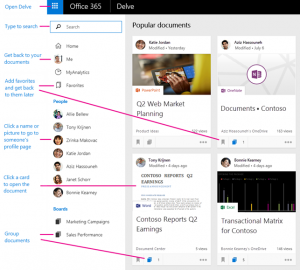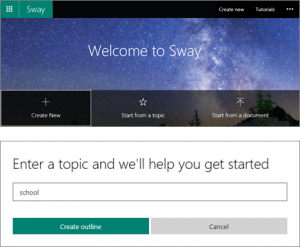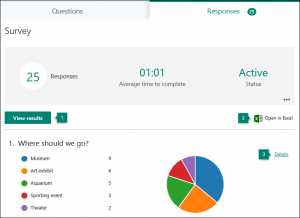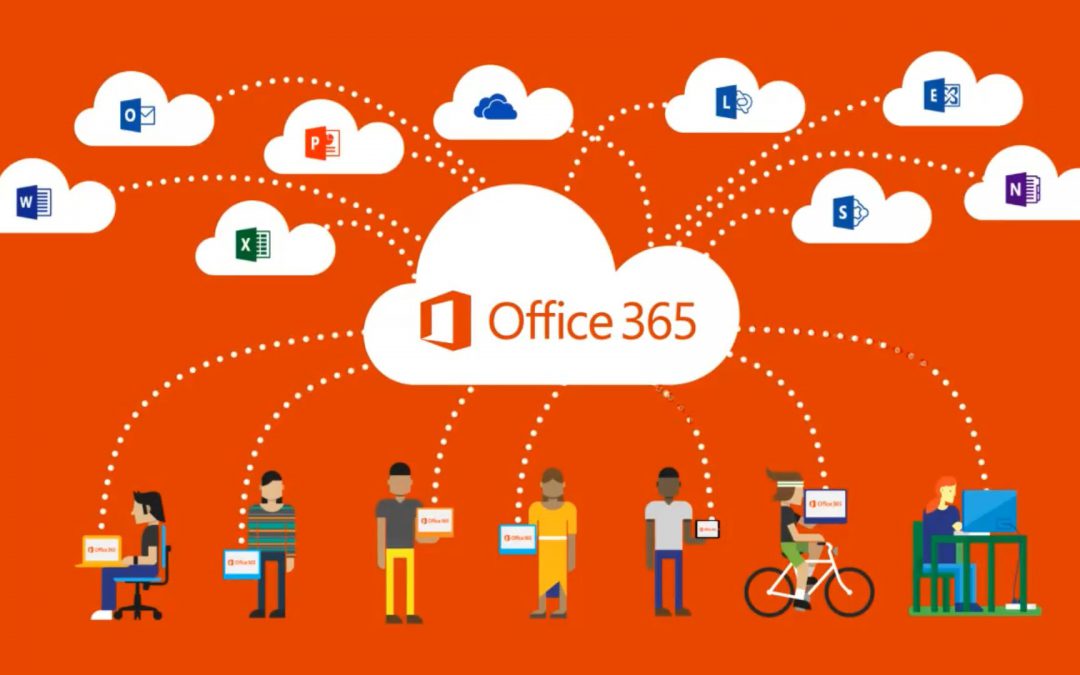Delve
Most organizations, large and small, dip their toes into the Office 365 (O365) pool by starting with a mail migration. Or maybe they want to move their mail and get files off their shared drives and into the Cloud. In either case, the best deal is to go for a subscription plan that has more than just mail and file sharing. While it’s easy to see the real-world use cases for some apps like OneDrive and SharePoint, there are a number of great apps that rarely get the attention they deserve. I’d like to take this opportunity to introduce you to some of the lesser known apps in Office 365. The apps in this review are included in both the Essentials and Premium versions of the O365 Small Business Plans as well as all of the Enterprise plans.
Delve is one of my favorite apps in O365 and in my experience most people don’t even know it’s there. One of the reasons that it’s so great is because there’s really nothing you need to do to “implement” it. Delve starts tracking the way you work within OneDrive, SharePoint and Outlook to surface your documents and the people you most frequently collaborate within one dashboard. You can pin documents to boards (think Pinterest but more of a focus on work than on recipes and DIY), bookmark your most frequently accessed content for easy access later, and find information about what your colleagues have been working on. Many organizations use it as a replacement for their employee directory. If your Active Directory is well structured and complete, then Delve will display each user’s email, phone number, picture, and place within the organization. You can even update some personal information including skills, birthday, projects you’ve worked on and more. Everything in Delve is searchable and permissions follow from wherever the content is housed. Documents aren’t stored in Delve, they still live in OneDrive and SharePoint and those permissions apply. If you’re the owner of a private document, then you’ll see it in Delve but it’ll have a lock icon so you know what’s public and what’s private. Have you ever gone so deep into a SharePoint site structure to find a document that you’re sure you’ll never find it again? By accessing it just that one time, it’ll show as a recent file in Delve and from there you can bookmark it for easy access. A couple clicks from the Waffle (officially called the App Launcher) and you’re back to it.

*Image courtesy of support.office.com
Check out more information on updating settings and reviewing storage in Delve.
Sway
I like to tell people that Sway is a great tool to play with on a quiet Friday afternoon. Sway is a presentation tool that is entirely web based. Think of those PowerPoint presentations you’ve created to show off a new release, product, or publication. These could be internal or external and maybe today you’re sending out the PowerPoint in an email (please stop doing this!) or posting it on your intranet or website. The assumption is that the recipient has PowerPoint or some way to view it. If you’ve embedded images or videos it might be a huge file as well. Instead, try using Sway. One of the best parts of Sway is that you can use a PowerPoint or Word Outline, upload it and Sway will translate the slides into what are called cards. You can choose from tons of designs as a starting point and customize even further to tell your story. Or you can start with a topic and Microsoft will suggest template Sways for you to choose from.

*Image courtesy of support.office.com
Easily embed videos, code, and high-resolution images without worrying about size limitations and then share a link to the Sway internally or externally. I like to use the visual link from my Sways and put them into my email signature! Microsoft uses Sway to show you How to Sway…they are creating videos to help us all keep up with this tool. Like I said, on a quiet Friday afternoon it’s a great tool to train yourself on and try out.
Forms
Forms seem to be getting more exposure among the O365 community. This tool was created initially for schools but soon the opportunities for use in the other subscription plans was evident. In the same way that Sway creates web-based presentations, Forms creates web-based forms and quizzes which can be shared internally and externally. It’s so easy to create a new form that training really isn’t necessary. There are basic design elements you can add to customize them or add a logo or image. Question types include choice, text, rating, date, ranking, and a Likert scale; you can also include branching. Results are sent to the creator of the Form, but you can use Flow (Microsoft’s Cloud-based workflow tool that is similar to IFTTT) to have others receive responses as well or share the form with your colleagues who also need to administer it. Responses are displayed in real-time charts for easy analysis!

*Image courtesy of support.office.com
Forms can be embedded in Sway, OneNote Online, OneDrive, Excel Online, and Teams. They’ve even added a Forms Web Part so you can insert a form into a SharePoint page! Although Forms isn’t a full-fledged replacement for InfoPath Forms, which I don’t think it was intended to be, it’s a great option. I have seen Forms used for business card ordering, gathering feedback, external ordering, comment cards, and more. You can also create a Group Form based on an O365 Group so that the owner of the form is the Group and not the individual. Because they’re so easy to create and share as well as integrate with the other O365 apps, they have a ton of potential for growth and a multitude of use cases!
To-Do
I’ll admit, I’m still playing with this app and deciding how it will fit in with how I manage my workload. In the past I have used flags in Outlook to mark the items that I need to go back to, these then show up in Tasks within Outlook. I have also used Planner and created my own Plan to then track my To-Do list as well as projects and service requests. To-Do has a very clean and concise interface. It starts by displaying a view called My Day which starts off empty every day. Items you didn’t complete the day before, move to another view called To-Do. In either view, you will enter all your To-Dos, or create other lists to organize your tasks. To-Do ties into Outlook and items you add in To-Do will appear in Outlook Tasks. You can also set reminders, mark tasks as important and easily move to different lists as your priorities change. To-Do Suggestions will highlight incomplete tasks to help you focus for the day. I think that To-Do has a lot of potential, and it will be interesting to see where Microsoft takes it. My hope is that they create some of the features of Wunderlist, which they purchased in 2015.

*image courtesy of products.office.com
Since I’m a list person and like to make lists just to check things off, I think that the ease of use and the stripped-down interface keeps it simple. I mean, all we are replacing is the pen and paper list right? And what’s so fancy about that? At least this way there’s a mobile app too! There’s More! In addition to the above apps, some others that are gaining traction include Flow, Stream, Planner, PowerApps, and Teams. These apps are a bit more robust than the ones I reviewed and perhaps in the future we’ll have a post on each of them. In the meantime, I’d encourage you to click around and take a look at the apps available in your subscription. You really can’t “break” anything. All of the above apps have a mobile app available to download, all you need to do is login with your O365 credentials. Check out the O365 Roadmap for new launches and see what’s in development. You can also visit the O365 Training Center for quick 1-3 minute videos on some, but not all, of the O365 apps.

